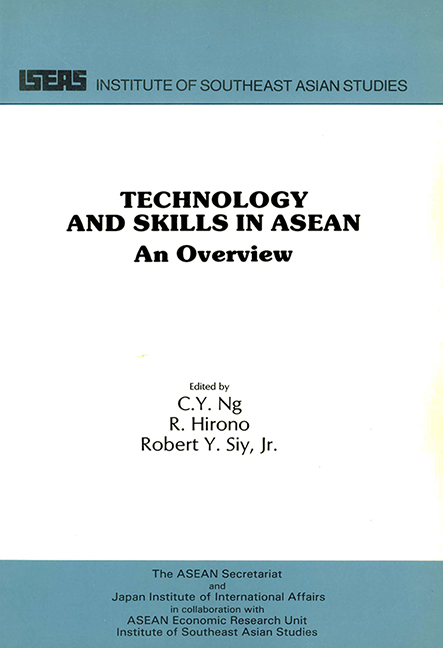Book contents
- Frontmatter
- Contents
- Foreword
- Preface
- PART ONE ASEAN OVERVIEW
- Introduction
- 1 Industrialization in ASEAN
- 2 Technology Transfer, Adaptation and Diffusion in Asean: Problems and Issues
- 3 Science and Technology Policies in Asean
- 4 The Experience From Selected Asean Industries
- 5 Conclusions and Recommendations
- PART TWO SECTION 1: JAPANESE OVERVIEW
- PART TWO SECTION 2: JAPANESE EXPERIENCES IN TECHNOLOGY TRANSFER
- The Editors
5 - Conclusions and Recommendations
from PART ONE - ASEAN OVERVIEW
Published online by Cambridge University Press: 09 November 2017
- Frontmatter
- Contents
- Foreword
- Preface
- PART ONE ASEAN OVERVIEW
- Introduction
- 1 Industrialization in ASEAN
- 2 Technology Transfer, Adaptation and Diffusion in Asean: Problems and Issues
- 3 Science and Technology Policies in Asean
- 4 The Experience From Selected Asean Industries
- 5 Conclusions and Recommendations
- PART TWO SECTION 1: JAPANESE OVERVIEW
- PART TWO SECTION 2: JAPANESE EXPERIENCES IN TECHNOLOGY TRANSFER
- The Editors
Summary
Although there were differences in emphasis between the individual countries of ASEAN, several themes were evident. One was the importance of organized skills development programmes and R&D activities as means for enhancing technology and skills. There was also the recognition that most country governments and multinational firms had major roles to play in facilitating and supporting the process of technology transfer and skills upgrading in ASEAN. Most governments were encouraged to support this process through the provision of required incentives, educational infrastructure and support institutions. Multinational firms were expected to expand their investments in training and R&D and to adopt a more liberal stance with respect to agreements concerning the use of proprietary technology. The papers also noted the need for stronger collaboration between private firms and the government, and between local firms and their foreign partners in various programmes and projects related to technological development in ASEAN.
Constraints to Enhancement of Technology and Skills
The five country studies cited numerous obstacles and impediments to the development of greater technological capacities. It was not at all surprising to find many common difficulties among the ASEAN countries. These constraints are grouped into four categories as follows:
a) constraints related to host country policies;
b) constraints related to practices of multinational firms;
c) constraints related to the characteristics of local firms; and
d) constraints related to the attributes and values of the local labour force.
Constraints Related to Host-Country Policies
The studies identified several constraints or problem areas which were related to domestic policies or host government regulations. In the Philippine study, the inadequacy of existing product standards was cited as a common problem of firms in the electronics industry. The firms claimed that variations in the quality of both production inputs and final products were extremely difficult to control. Firms were often forced to source even locally available raw materials from foreign sources in order to maintain a certain level of quality and standardization of products.
- Type
- Chapter
- Information
- Technology and Skills in ASEANAn Overview, pp. 59 - 70Publisher: ISEAS–Yusof Ishak InstitutePrint publication year: 1988

